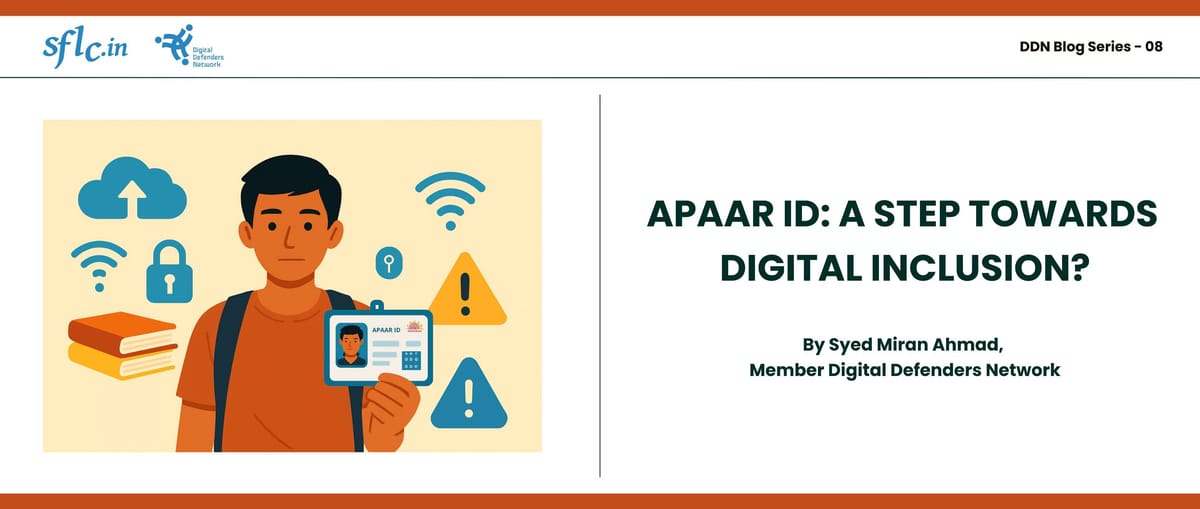Since the dawn of human civilisation, there has always been a tussle between civil liberties and how much governments can interfere with or control information. How much interference is too much interference? Or should there even be any at all? These are thought-provoking questions, ones that offer no easy answers, but perhaps that is the point. Life is not meant to be simple, and that complexity is what makes it compelling. This debate echoes the challenges posed by Aadhaar, which serves as the foundation for many of the government’s digital identity initiatives. Aadhaar, introduced in 2009, was originally designed to provide a unique identification system for citizens, primarily to streamline access to welfare programs. However, it has since evolved into a critical tool across various sectors. By linking individuals' identities to biometric data, Aadhaar has made it possible for the government to centralize and digitize many services. It was claimed that Aadhar would serve as a convenient means to increase administrative efficiency and streamline access to welfare schemes. However, the introduction of such systems raises concerns about digital privacy and the shifting balance between convenience and control, a conversation that intensifies as these initiatives grow.
APAAR: A Digital Academic Identity
APAAR, short for Automated Permanent Academic Account Registry, is an initiative under the National Education Policy (NEP) 2020, introduced by the Ministry of Education. Think of it as a lifelong academic identity number, a kind of Aadhaar for academic records. Every student, from kindergarten to university, will be assigned this unique ID. Through this ID, all academic data marksheets, certificates, skills, extracurriculars, even co-curricular achievements can be tracked, stored, and accessed on a centralized digital platform. Recently, the Central Board of Secondary Education ("CBSE") made APAAR ID linkages mandatory for all students, with implementation to begin from CBSE Board Exams, scheduled to be held in 2026.
The government presents this initiative as a transformative step toward simplifying record-keeping and ensuring seamless mobility across educational institutions whether for school transfers, college applications, or even employment opportunities. It envisions a future where physical documents become redundant, replaced by a secure, digital infrastructure that eliminates the need to search through physical files for certificates and transcripts. It's paperless, supposedly secure, and meant to reduce red tape.
However, critics have raised concerns about the implications such an initiative on data control, security, and the potential for misuse concerns that echo broader anxieties about centralised digital governance.
The Good: Could it actually be a Game changer?
To give credit where it is due, on paper (or well, on the cloud), APAAR has some genuinely compelling features. For a country like India, with its vast, diverse, and often chaotic education system, a unified, digital student ID could be a much-needed step toward streamlining and modernizing academic record keeping. All academic data including marksheets, certificates, skill records, extracurricular and co-curricular achievements will be digitally stored and consolidated. This eliminates the need for students and parents to hunt down scattered documents or certificates from years past. With APAAR, a student's complete academic record, from pre-primary to postgraduate levels, is stored in one place. It is portable, accessible, and, in theory, entirely paperless. Whether applying to a new school, switching boards, or seeking employment, the educational trail is well-documented and only a few clicks away.
APAAR also plugs into the Academic Bank of Credits (ABC), a system designed to let students collect, store, and use “credits” earned from various courses across institutions. This is positioned as a significant step toward educational flexibility. Want to take a break mid-degree? Switch streams? Explore cross-disciplinary learning? The credits follow the student. It encourages a much more fluid, modular education model, one that actually aligns with how modern learning works.
Then there is the added advantage of addressing, though not eliminating, the issue of fake degrees and fraudulent mark sheets. While digital records can still be tampered with, the use of verified, centralized databases might make manipulation more difficult and easier to detect. However, the robustness of these security measures remains to be seen. If the recurring security lapses in the Aadhaar system are any indication, the promise of tamper-proof academic records under APAAR may not be entirely reassuring. Furthermore, employers, universities, and scholarship boards can cross-check credentials instantly, no more “lost in translation” or tampered transcripts. Moreover, APAAR aligns with the government’s broader Digital India initiative and its push for e-governance. In a world moving rapidly toward digital-first systems, this is the kind of infrastructural reform that could theoretically help leapfrog some of the inefficiencies in the education system.
However, most if not all of the benefits that APAAR promises were being done even before the advent of APAAR. Schools and universities have had the ability to digitize records for years now. Centralized databases? Not a new concept. Secure verification? Already possible. The only real thing APAAR brings to the table is convenience and even that convenience is not exactly free.
Because, as with most things that promise to make life easier, there’s a catch.
The Bad: It’s not all sunshine and digital harmony.
As with most government-led “convenience” initiatives, there’s always a trade-off and APAAR, for all its streamlining promises, brings with it a familiar sense of déjà vu, particularly when compared to the Aadhaar experience. The original golden child of digital India, the Aadhaar Card. Sold as the holy grail of identity security and efficiency. Aadhaar, was portrayed as a transformative intervention to enhance welfare delivery by promoting inclusion and reducing corruption. Originally introduced as a voluntary ID, it has over time become de facto mandatory for accessing most welfare schemes and services. Despite early warnings from experts and civil society about its limited capacity to achieve these objectives, succeeding governments have expanded its application. Using a variety of independent reviews and audit reports, it has become increasingly evident that Aadhaar has often done the opposite of what it promised. Instead of fostering inclusion, Aadhaar has led to the exclusion of many from essential welfare services due to authentication failures and bureaucratic rigidity. Moreover, despite repeated assurances of robust safety and encryption, Aadhaar has faced significant security lapses. The most alarming was the reported leak of sensitive data belonging to over 81.5 crore Indians, allegedly found on the dark web, an incident that can hardly be dismissed as a mere glitch. Such breaches not only undermine public trust but also raise serious concerns about the government’s ability to safeguard digital identities. In its current form, the Aadhaar project, while touted as a cornerstone of digital governance, risks undermining the right to life by making access to basic services contingent upon a flawed technological infrastructure.
Which brings the discussion to APAAR.
On the consent form that parents are supposed to sign, it clearly states:
“…..that my APAAR ID may be used and shared for limited purposes as may be notified by Ministry of Education from time-to-time for educational and related activities. Further I am also aware that my personal identifiable information (Name, Address, Age, Date of Birth, Gender and Photograph) may be made available to entities engaged in various educational activities such as UDISE+ database, scholarships, maintenance academic records, other stakeholders like Educational Institutions and recruitment agencies.”
That’s vague enough to raise concerns. 'Limited purposes' could encompass virtually anything. More troubling is that it remains entirely at the Ministry’s discretion whether it even discloses when and why the data is being shared. In effect, blanket consent is being given without any real agency or transparency regarding who is handling a child's data and for what purpose. And for those assuming that consent can simply be withdrawn later if discomfort arises, the form itself goes on to state otherwise:
“I understand that I can withdraw my consent for all or any of the purposes at any time… however, any personal data already processed shall remain unaffected on such withdrawal of consent.”
Basically, once the data is out there, it’s out there baked into the systems, copied across platforms, maybe even sold to third parties. Revoking consent doesn’t magically delete the trail.
Furthermore, the implication of personal data becoming corporate gold is not entirely unfamiliar. Imagine coaching institutes, already feeding off the chaos of competitive exams, gaining access to a child’s academic history. Suddenly the marketing becomes hyper-targeted, intrusive, and relentless. The system manufactures pressure, only to sell a solution in return. While the APAAR framework claims to safeguard user privacy, its policy includes broad allowances for data sharing with “authorized third parties” and “credential evaluation agencies”. Users are also subject to the privacy policies of external institutions integrated with APAAR, diluting any uniform guarantee of data protection. In such an ecosystem, ed-tech firms flush with investor money may well find the perfect tool to personalize insecurities.
Then come recruiters, who already hold most of the power in hiring processes. Now, recruiters gain access to an individual’s complete academic timeline, not just the carefully curated highlights presented on a résumé. A difficult semester during the COVID-19 pandemic? A subject dropped due to personal circumstances? All on record. All fair game for silent judgment. The reality is that most individuals have those moments, low grades, lost years, wrong turns but when those moments are frozen in data, stripped of context, and handed to people who don’t know the actual story, it becomes a tool for judgement, not a record.
So while APAAR might promise digital empowerment, it risks evolving into a surveillance adjacent ecosystem, one that not only monitors but potentially monetizes every academic move a student makes, under the guise of consent and efficiency. Collecting and storing such detailed educational data in one place raises serious privacy concerns, especially since it’s still unclear who can access the data, how long it will be kept, or how it might be shared. Though APAAR is not mandatory at present, the pressure to opt in, whether from institutions or policy shifts, could soon make it functionally compulsory, much like Aadhaar. If accessed by third parties, be it private companies, marketing agencies, or even state institutions, this data can be used to profile, influence, and target students in ways that strip them of agency. When predictive analytics, behavioural scoring, and algorithm-driven recommendations enter the picture, education risks being shaped less by genuine interest or aptitude and more by what the system ‘thinks’ a student should pursue. Though disclaimers and opt-ins may preserve the illusion of control, the actual power lies with institutions and corporations leaving students and families exposed, with limited recourse in the event of misuse or breaches.
The Ugly: Convenience as the new Soma
Is there truly a tug-of-war between civil liberties and government control, or have citizens simply grown accustomed to losing the rope?
Locke, in his theory of the social contract, argued that individuals willingly surrender certain rights in exchange for protection, order, and governance (Locke, 1988). Fair, but what happens when the government, left to its own devices, begins to demand more?
George Orwell's 1984 envisioned a world ruled by brute force where fear ensured obedience and surveillance was absolute (Orwell, 2021). However, force isn’t always necessary. Why use fear when convenience works better? Aldous Huxley’s Brave New World imagined something subtler, a world where citizens willingly surrendered autonomy for comfort, distracted by pleasures, pacified by Soma, a fictional drug that made everything feel alright. The illusion of freedom was more effective than chains. Therefore, it begs the question: what’s our Soma?
APAAR, if considered in isolation, may appear to be a well-intentioned step toward digital inclusion. It promises seamless academic mobility, easier access to scholarships, and streamlined documentation, all noble goals in a country grappling with educational inequities. It sounds perfect, except you're not just a student anymore, you're also part of a larger dataset. A student's academic identity becomes algorithmic fodder for institutions to judge, employers to mine, and corporations to exploit. The system doesn't recognize a child who overcame adversity. It cannot measure potential, only predict performance based on historical data points. This reveals APAAR's fundamental paradox: while capable of perfect digital recall, the system remains incapable of human understanding.
Furthermore, APAAR won’t exist in a vacuum. It will inevitably be linked to Aadhaar, Digi-Locker, PAN, Digi-Yatra, credit scores, and whatever future “solutions” roll out, much like Aadhaar was linked to various services and platforms, APAAR will also seamlessly weave into the larger digital fabric of personal data. As these systems converge, so do the fragmented pieces of an individual’s life test scores, discipline records, attendance, travel history, and financial footprints. Each new feature will be presented as progress, each step “more convenient” than the last. Though APAAR is officially voluntary, in practice, individuals are already being pressured into compliance by increasingly digitized systems. With our growing reliance on digital infrastructure, the question is no longer if such initiatives will become compulsory, but how subtly that compulsion will unfold. What begins as a choice will soon become just another obligatory link in the expanding chain of digital identity?
Privacy in the age of Passive Consent
The erosion of privacy in the digital age never arrives with fanfare or confrontation. It seeps in gradually through the innocuous click of 'I agree' on vaguely worded consent forms, through temporary pilot programs that quietly solidify into permanent policy, through the slow normalization of surveillance disguised as convenience. By the time society pauses to question what has been surrendered, the infrastructure is already omnipresent, the data irrevocably dispersed across servers.
This is where the concern about APAAR morphs from caution to urgency. When a system has the potential to create an unbroken chain of personal information, from kindergarten performance to employment history, it goes beyond convenience. It enters the realm of surveillance-by-design. By mapping the academic lives of children and young adults, storing that data indefinitely, APAAR risks becoming a privacy-invading mechanism, regardless of the original intent.
APAAR is being positioned as a vital component of the government’s Digital India mission, promising seamless access to academic records, efficient verification, and smoother administrative processes. By making educational data digitally accessible, the initiative claims to modernize learning and reduce paperwork. But behind this drive for convenience lies a deeper shift in the relationship between citizens and the State: one where participation, though technically voluntary, increasingly feels obligatory.
More worryingly, APAAR represents a new frontier in the normalization of data centralization without adequate privacy. The consolidation of academic histories, demographic details, and institutional affiliations into a single digital identity may be efficient, but it also creates a rich trove of personal data ripe for misuse. APAAR is not just a tool for academic tracking, it is a revealing test case of how quietly and deeply digital governance can reshape the meaning of consent, participation, and privacy in modern India.


